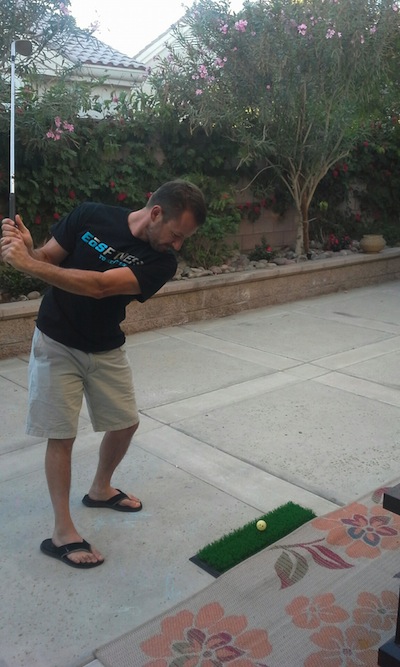
As the desert high-season turns toward a spring sizzle, I always find it a good time to assess my golf game and review what strides I've made over the peak months.
Personally, I keep a few golf goals in mind, namely: Break 80 and reduce my handicap to single-digits.
Per the latter: That hasn't happened yet (though I'm down to a 13.4 in my latest revision).
And the former? Well, I hadn't broken 80 since nearly two years ago.
And I offer "hadn't" as – in recent weeks — I finally broke the streak of above-80 rounds.
Here are five reasons why it happened:
1. The Tune-up

photo courtesy of judd spicer
I try to continually groove my swing with 100 practice cuts every day, whether at the range or in the backyard.
I've long learned that I play my best when grooved. There are some folks with innate athletic abilities who can pick up the clubs a few times a month and go shoot an 82. That's not me.
To keep my feel, I've worked harder of late to make time for around 100 practice swings a day. If I can't make it to the course or range, I just do so in the backyard.
2. The Course
Breaking 80 (or achieving whatever your individual goal may be) isn't just a measure of personal comfortability – it's also a matter of feeling at ease with your surroundings.
As I've noted previously, Marriott's Shadow Ridge in Palm Desert is among my favorite courses. My fondness for the routing aside, the course just suits my game with its generous landing areas from the tee and speedy greens.
Of course, it took a few dozen rounds to gain a true sense of course knowledge and to understand the nuance of ball placement. But once I gained full acumen of where to try and place my tee shots and which approaches to handle with extra consideration – I now step to each shot with confidence.
3. The Prep
Prior to the round in question, I enjoyed a thorough pre-round prep. If you or your playing partners are like many of my own pals, you hit 10 balls, roll 10 putts and hustle to the first tee. I've gotten into the bad habit of doing that as well.
But of late, I've worked harder to give myself a full 45-minutes of pre-round stretching, ball striking, chipping and putting. In addition, I've been using an old range tip which involves hitting balls in sequence instead of banging 25 drivers in a row.
In other words, I imagine a hole, then hit driver, then 7-iron, then wedge, and so worth. The process takes a little extra patience, but give it a shot and see if it works for you.
4. The Tees
I'm not too proud to say that for the sub-80 round, I moved up to the course's "Combo" tee, playing at 5,708 yards. That may prove too little course for those of the sub 15-handicap set (and add an asterisk to a good score for some), but personally, I've become a big proponent of moving up a tee.
If you're a scratch player, go play from the tips. If you're a mid-to-high handicapper, a shorter tee is oftentimes more fun, makes the game move faster, and keeps you alive for par on more holes.
5. The Driver

photo courtesy of callaway golf
I don’t image trading in the Callaway FT-IQ anytime soon.
Lastly, what put me under 80 was the big stick.
For years, I've debated my pals and colleagues about the most important club in a golf bag, and, historically, my opinion has been that a superb wedge game is necessary. The thinking was that the mid-handicapper is only going to find so many greens in regulation, meaning, most of the time, he or she requires a great pitch or chip to make par.
But a few months' back my gal found me a somewhat dated, but well-conditioned Callaway FT-IQ Driver that — for reasons I won't pretend to understand – just suits my eye and my swing. I had used upwards of five different drivers in the past two years, and it got so bad with this turnstile that I simply resorted to hitting my trusty 5-wood off most tees.
Yet a booming driver truly creates an entirely different world. To find yourself 270 yards in the short grass on most par 4s or short par 5s should all but guarantee a bogey at worst, no matter if your short game is average.
What is your story on achieving a personal-best score? Share it with me at [email protected].
Judd Spicer is a member of the Golf Writers Association of America. Follow Judd on Twitter: @JuddSpicer
See Judd's previous posts under Life on the Links.
Like what you're reading? Then "Like" us on Facebook and "follow" us on Twitter.